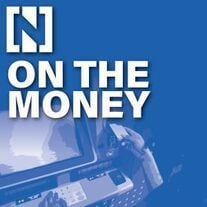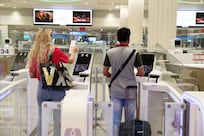Summer is coming, and all too often that spells a slowdown for the stock market, as traders grow drowsy and dream of beaches.
Many recall the old advice to “Sell in May and go away …” and wonder whether there’s truth in it.
April was the cruellest month, with the S&P 500 falling 4.1 per cent. With the long-awaited first US interest rate cut postponed to the autumn, or possibly 2025, investors could be forgiven for having sunshine on their minds, rather than stocks and shares.
Those feeling guilty about absenting themselves can take solace from summers past, says Tony Hallside, chief executive of Dubai-based prime brokerage firm STP Partners.
“Historically, the S&P 500 has grown just 2 per cent for the six months from May through October, compared with a 7 per cent gain from November through April.”
While this supports the “Sell in May” thesis, as ever with investing, past performance is no guide to the future, Mr Hallside warns.
Not every summer is a washout. So, what about this one?
Mr Hallside is wary as the spring rally has left stocks looking overvalued.
“Investors are right to be cautious, due to the potential for a correction,” he says.
Selling in May – or any month – is never a good idea, unless you need the money. It's better to sit tight, let the dividends roll in, and keep an eye open for opportunities.
“Investors should consider adopting a defensive approach, taking advantage of the recent pullback to buy quality stocks at lower prices,” Mr Hallside says.
Fears that 2024 would be a cruel summer for investors have been fuelled by US consumer price inflation, which climbed from 3.2 per cent in February to 3.5 per cent in March, instead of falling as hoped.
Markets had hoped for six interest rate cuts across 2024, which would cut borrowing costs and increase growth.
With inflation proving hot and sticky, they now expect two at best, with the first delayed until September. We may get none at all.
Marc Pussard, head of risk at APM Capital, says that given today’s heavy weather, even buying the dip may be risky.
The S&P 500 is up 6 per cent this year, despite April’s dip, which he suggests looks “frothy”, given that the US economy grew a disappointing 1.6 per cent in the first quarter.
A recession cannot be ruled out, either. The US yield curve has been signalling a slump since July 2022.
“If that continues, it would only be a matter of time before equity markets reflect this sentiment,” Mr Pussard says.
He notes that US Federal Reserve chair Jerome Powell has said that its decisions will be data-dependent.
“Maybe this isn’t the time to buy the dip, but rather sit on your hands and wait for more data,” Mr Pussard says.
Or sit on the beach, maybe? It’s tempting.
Yet, there was a flurry of excitement when April's US labour market report was published last week and turned out to be softer than expected.
“With fewer job gains, moderate earnings growth and slightly higher unemployment, the market is seemingly finally cooling,” says Julius Baer chief economist David Kohl.
“Lower inflation risks increase the probability of more rate cuts in 2024.”
Just not in the summer. “We continue to expect the Fed to start cutting at its September meeting,” Mr Kohl adds.
Mohamed Hashad, chief market strategist at Noor Capital, is not expecting a cool, quiet summer.
Not with inflation high, trading volumes down and inflation falling faster in Britain and Europe than in the US.
Monetary policies are starting to diverge. “Inflation is declining in the EU and the UK, but interest rate volatility exists in Japan,” he says.
The UK was hit harder by the inflation shock than most, because of its reliance on imported oil and gas. Now price growth seems to be slowing faster than elsewhere. April’s data could see inflation falling back to the Bank of England’s 2 per cent target.
If that happens, the central bank will come under intense pressure to slash interest rates even if the Fed doesn't.
The UK economy desperately needs a lift, with the Organisation for Economic Co-operation and Development predicting it will be the slowest growing in the G7 over the next two years.
While Wall Street fell in April, London's FTSE 100 broke the 8,000 barrier for only the second time ever, as it hit a string of all-time highs.
UK shares remain cheap after Brexit, and international investors have taken note.
Eurozone inflation fell to just 2.4 per cent in March, which means the European Central Bank could have a decision to make, too.
Yet the US still leads the way and it’s facing a bumpy summer, says Vijay Valecha, chief investment officer at Century Financial.
US tech has driven the market rally, but Nvidia and Tesla look pricey.

“The S&P 500 is trading at about 20 times earnings forecasts, above the historical average. Strong earnings alone may not sustain the rally, and companies will need to consistently surpass estimates to justify higher stock prices,” he adds.
Investors are becoming more demanding and seeking positive surprises. They may not get them, Mr Valecha says. “Stagflation is a real risk.”
With US interest rates stuck at a 22-year high, borrowers are coming under pressure, increasing the risk of company defaults.
“In a higher-for-longer interest rate environment, firms are depleting their cash reserves as earnings moderate and debt servicing costs rise,” Mr Valecha says.
The International Monetary Fund highlighted the growing number of small and medium-sized companies whose cash reserves are running low, he adds.
“Defaults are also increasing in the leveraged loan market, where financially weaker firms borrow, yet most investors have disregarded these concerns.”
Mr Valecha suggests that investors should “go light on their equity investments”, and even consider seeking safety in US government bonds.
Many will read that and wonder whether they should follow their instincts and hit the beach after all.
The excitement may arrive in September when we get that first-rate cut.
It’s tempting but investors shouldn’t completely tune out. Markets called spring wrong. Summer might be full of surprises, too.






